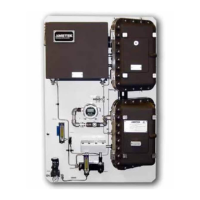Maintenance and Troubleshooting | 6-33
2. Analyzer with Heated Cells:
Remove the Insulating Jacket or open the Oven door to allow the Cell
to cool down enough to work on it.
3. If the analyzer uses measured Pressure Compensation (optional),
change the pressure compensation to fixed mode so that a “f: Sample
gas pressure too low” alarm does not occur. To do this, view the Cell/
Misc Parameters dialog box and enter a value in the Default Cell
Pres (pressure compensation) field that is the same as, or approxi-
mately, the Measuring Cell pressure. Refer to “Cell/Miscellaneous
(Compensation) Parameters” in Chapter 4.
Close the isolation valve on the Sample Line or Sample Probe (if used).
Backpurge the analyzer sample system with Zero gas for 2–3 minutes.
4. Change the Flow Control setting to ‘1’ (shut-in/off). Click Apply (next
to Flow Control) and then click OK.
Bleed down the sample system to atmospheric pressure (check gauge).
Close the valve on the Vent Line side (or cap the Vent outlet).
If the sample system does not have an isolation valve, Zero gas may
continue to flow. Shut off the Zero gas.
5. Disconnect AC power to the analyzer and power down the computer
before performing maintenance on the analyzer.
6. Remove the Optical Bench from the Upper Enclosure:
While removing the Optical Bench from the Upper Enclosure, grasp
it by the upper portion of the Optical Bench to support it; do not sup-
port the assembly by its circuit boards or source lamps. Also, take care
not to damage the enclosure’s joining areas (flamepath).
a. Remove the (24) M10 screws from the Upper Enclosure door and
open it.
NOTE
!
WARNING
Setup (tab)Cell/Misc

